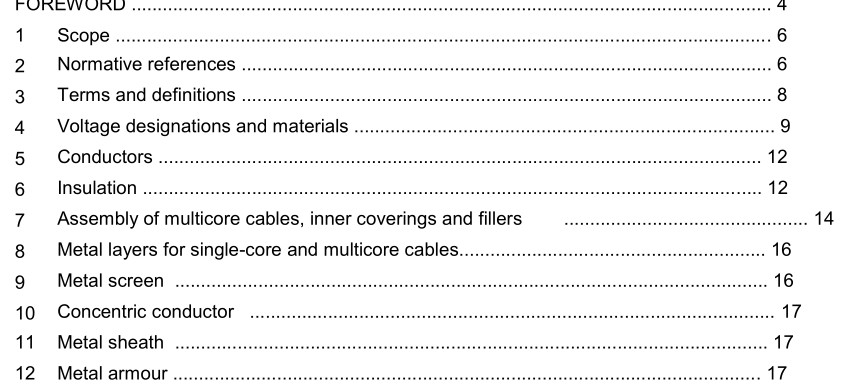IEC 60502-1-2021 pdf Power cables with extruded insulation and their accessories for rated voltages from 1 kV (U m = 1,2 kV) up to 30 kV (U m = 36 kV) – Part 1: Cables for rated voltages of 1 kV (U m = 1,2 kV) and 3 kV (U m = 3,6 kV)

The temperatures in Table 3 are based on the intrinsic properties of the insulating materials. It is important to take into account other factors when using these values for the calculation of current ratings. For example, in normal operation, if a cable directly buried in the ground is operated under continuous load (100 % load factor) at the maximum conductor temperature shown in Table 3, the thermal resistivity of the soil surrounding the cable may, in the course of time, increase from its original value as a result of drying-out processes. As a consequence, the conductor temperature may greatly exceed the maximum value. If such operating conditions are foreseen, adequate provisions shall be made. For guidance on the short-circuit temperatures, reference shall be made to IEC 60724. 4.3 Sheathing compounds The types of sheathing compound covered by this document are listed in Table 4, together with their abbreviated designations. The maximum conductor temperatures for the different types of sheathing compound covered by this document are given in Table 4.
7.4 Cables with rated voltage 1,8/3 (3,6) kV 7.4.1 General Cables with a rated voltage of 1,8/3 (3,6) kV shall have a metal layer surrounding the cores either individually or collectively. 7.4.2 Cables having only a collective metal layer (see Clause 8) Cables shall have an inner covering over the laid-up cores. The inner covering and fillers shall comply with 7.2 and shall be non-hygroscopic. 7.4.3 Cables having a metal layer over each individual core (see Clause 9) The metal layers of the individual cores shall be in contact with each other. Cables with an additional collective metal layer (see Clause 8) of the same material as the underlying individual metal layers shall have an inner covering over the laid-up cores. The inner covering and fillers shall comply with 7.2 and shall be non-hygroscopic. When the underlying individual metal layers and the collective metal layer are of different materials, they shall be separated by an extruded sheath of one of the materials specified in 13.2. For lead-sheathed cables, the separation from the underlying individual metal layers may be obtained by an inner covering in accordance with 7.2. For cables having neither armour, nor concentric conductor, nor other collective metal layer (see Clause 8), the inner covering may be omitted, provided the outer shape of the cable remains practically circular. The oversheath may penetrate into the interstices of the cores, except in the case of thermoplastic oversheaths over circular cores exceeding 10 mm 2 . If, however, an inner covering is applied, its thickness need not comply with 7.2.3 nor 7.2.4.
- Previous:IEC 60695-11-11-2021 pdf Fire hazard testing – Part 11-11: Test flames – Determination of the characteristic heat flux for ignition from a non-contacting flame source
- Next:IEC 60433-2021 pdf Insulators for overhead lines with a nominal voltage above 1 000 V – Ceramic insulators for AC systems – Characteristics of insulator units of the long rod type
- ISO IEC 27050-4-2021 pdf Information technology — Electronic discovery — Part 4: Technical readiness
- ISO IEC 27036-1-2021 pdf Cybersecurity — Supplier relationships — Part 1: Overview and concepts
- ISO IEC 27013-2021 pdf Information security, cybersecurity and privacy protection — Guidance on the integrated implementation of ISO/IEC 27001 and ISO/IEC 20000-1
- ISO IEC 26580-2021 pdf Software and systems engineering — Methods and tools for the feature- based approach to software and systems product line engineering
- ISO IEC 24735-2021 pdf Information technology — Office equipment — Method for measuring digital copying productivity
- ISO IEC 24711-2021 pdf Information technology — Office equipment — Method for the determination of ink cartridge yield for colour inkjet printers and multi- function devices that contain printer components
- ISO IEC 23544-2021 pdf Information Technology — Data centres — Application Platform Energy Effectiveness (APEE)
- ISO IEC 23510-2021 pdf Information technology — 3D printing and scanning — Framework for an Additive Manufacturing Service Platform (AMSP)
- ISO IEC 23127-1-2021 pdf Information technology — Learning, education, and training — Metadata for facilitators of online learning — Part 1: Framework
- ISO IEC 23126-2021 pdf Information technology for learning, education and training — Ubiquitous learning resource organization and description framework
- IEC 60850-2007 pdf Railway applications一 Supply voltages of traction systems
- IEC 60305-2021 pdf Insulators for overhead lines with a nominal voltage above 1 000 V – Ceramic or glass insulator units for AC systems – Characteristics of insulator units of the cap and pin type
- IEC 62576-2009 pdf Electric double-layer capacitors for use in hybrid electric vehicles – Test methods for electrical characteristics
- IEC 62430-2009 pdf Environmentally conscious design for electrical and electronic products
- IEC 60644-2009 pdf Specification for high-voltage fuse-links for motor circuit applications
- BS ISO IEC 15420-2009 pdf Information technology一 Automatic identification and data capture techniques EAN/UPC bar code symbology specification
- BS IEC 60860-2014 pdf Radiation protection instrumentation一 Warning equipment for criticality accidents
- BS ISO IEC 19762.5-2008 pdf Information technology一 Automatic identification and data capture (AIDC) techniques – Harmonized vocabulary Part 5: Locating systems
- ISO IEC 24711-2021 pdf Information technology — Office equipment — Method for the determination of ink cartridge yield for colour inkjet printers and multi- function devices that contain printer components
- ISO IEC 24735-2021 pdf Information technology — Office equipment — Method for measuring digital copying productivity